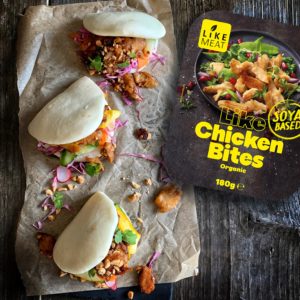Every day I’m seeing more and more news on restaurants adding meat replacements to their menus and new companies developing meat-like alternatives. This time and age vegans (or just those who want to cut down on meat consumption) are experiencing the best in plant based “meat”. How lucky are we that if, as a new or even seasoned vegan or vegetarian, we crave the taste of a burger, chicken, or even bacon, and it’s as easy as visiting the grocery store to get it?
Plant based “meat” has come so far in the last ten years, just imagine what vegan food will be like ten years from now. Of course, it all had to start somewhere. The first mention of tofu is found in 995 CE in Simple and Exotic by Chinese writer Tao Ku. The text states that, “when Shi Ji was the magistrate of Qing Yang, he emphasized the virtue of frugality among the people, and discouraged the consumption of meat. Instead he promoted the sale of tofu.” Pretty cool. There’s an old legend about how tofu was created that you can read about here, although apparently there are a few different stories.

The roots of vegetarianism go even further than that, though. “Among some of the first who practiced eating plant-based were followers of Pythagoras of Samos around 500 BCE. Believing that Pythagoras’ strict dietary regimen (which was motivated by his principle that we should be kind to all living species) aided his health and longevity, his followers or “Pythagoreans” marked one of the first publicly branded population who didn’t consume meat products,” says Green Queen.
But I want to focus on the evolution of meat alternatives here. And when you think about it, tofu or textured soy protein is still the base for most of our meat-mimicking alternatives. So this is really what lead us toward where we are today. Yuba (tofu skin) was first found mentioned in a Chinese text in 1587. So almost 600 hundred years later, we can see vegetables being engineered to have meat mimicking aspects—such as skin.

It wasn’t long before experimenting with tofu went to the next level. Ever eat a Tofurky? Well, the first mention of mock poultry was found in 1790 where ‘mock roast goose with yam wrapped in yuba’ is found within Recipes from the Sui Garden by Yuan Mei. But why did tofu gain such popularity and why was it so sought after in China? China Daily writes that “tofu was simple in production and cheap in cost.” This, mixed with its nutritional value, versatility, and availability made it popular among Chinese people.
Meat alternatives didn’t start showing up in texts in the Western world until around 1852, where a “vegetable sausage” made from red fennel and turnip tops, is written about in the New Hampshire Patriot and State Gazette as an “important invention.” We can see other meatless mentions, but don’t see any more food engineering until 1985 in the New York Vegetarian Society’s Banquet meal of “meatless turkey.”

In 1896, Nuttose was launched as the first commercially available meat alternative in the West, made by none other than Dr. John Harvey Kellogg (of the Kellogg’s brand). Nuttose was the world’s first canned meat alternative and was primarily made from peanuts, somewhat resembling “the appearance and flavor of cold roast mutton,” as quoted in Good Health magazine.
In 1911, in France, cold cuts made from soy popped onto the scene. In 1922, The first soy-based meat alternative was developed by Madison Foods in Tennessee. From then on, most meat alternatives would be made from soy or a soy-and-what-gluten mix. In 1929 a meatless, bacon-flavored soy powder was put on the market. Which I would regard to be the first step towards the fake bacon we have today.

In the 1960s and 70s, “hippies” (who adhere to health-food movements developed in Southern California) broke onto the scene in the Western world, and the vegetarian movement gained popularity. Various frozen and canned meat alternative companies were created including Worthington, Morning Star, Boca, and Yves. It wasn’t until 2002 that Burger King became the first major fast food restaurant ever to add a veggie burger to its menu.

Over 2,000 years of experimenting, trials and errors, food trends, religious movements, and happy accidents have led us to where we are today. And today, we can choose from eerily meat-mimicking products like the Impossible Burger, to whole plant-based options like cauliflower “wings” and vegetable “steaks,” and anything in between. One thing is for certain: with a culinary history going back millennia, vegan meat alternatives can’t be said to be “not as natural as meat.”
Get more like this—Sign up for our daily inspirational newsletter for exclusive content!
__
Photo: Sherman Kwan, Kelly Sikkema, Grooveland Designs, Hamburguesa Casera, Like Meat; Unsplash.




